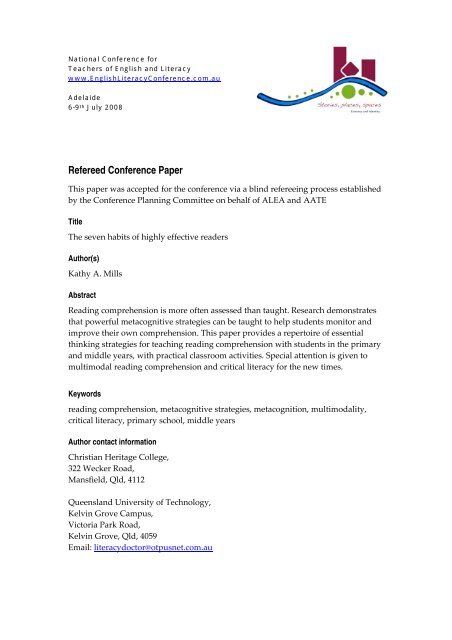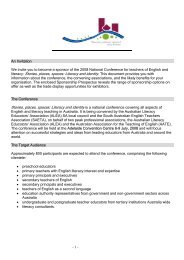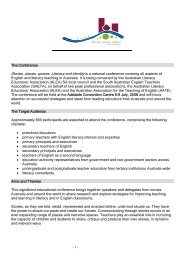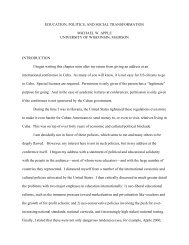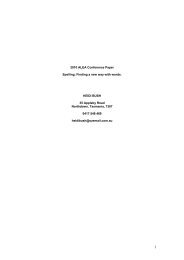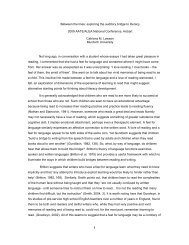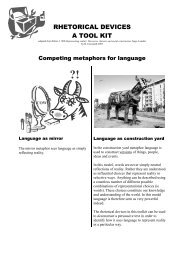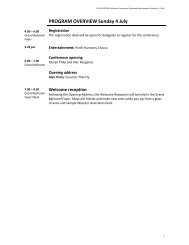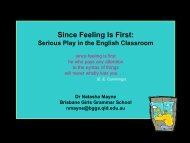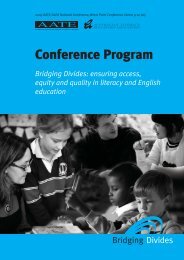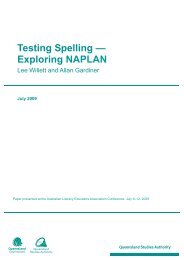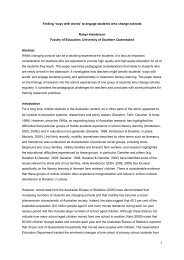The seven habits of highly effective readers - AATE/ALEA National ...
The seven habits of highly effective readers - AATE/ALEA National ...
The seven habits of highly effective readers - AATE/ALEA National ...
You also want an ePaper? Increase the reach of your titles
YUMPU automatically turns print PDFs into web optimized ePapers that Google loves.
<strong>National</strong> Conference for<br />
Teachers <strong>of</strong> English and Literacy<br />
www.EnglishLiteracyConference.com.au<br />
Adelaide<br />
6-9 th July 2008<br />
Refereed Conference Paper<br />
This paper was accepted for the conference via a blind refereeing process established<br />
by the Conference Planning Committee on behalf <strong>of</strong> <strong>ALEA</strong> and <strong>AATE</strong><br />
Title<br />
<strong>The</strong> <strong>seven</strong> <strong>habits</strong> <strong>of</strong> <strong>highly</strong> <strong>effective</strong> <strong>readers</strong><br />
Author(s)<br />
Kathy A. Mills<br />
Abstract<br />
Reading comprehension is more <strong>of</strong>ten assessed than taught. Research demonstrates<br />
that powerful metacognitive strategies can be taught to help students monitor and<br />
improve their own comprehension. This paper provides a repertoire <strong>of</strong> essential<br />
thinking strategies for teaching reading comprehension with students in the primary<br />
and middle years, with practical classroom activities. Special attention is given to<br />
multimodal reading comprehension and critical literacy for the new times.<br />
Keywords<br />
reading comprehension, metacognitive strategies, metacognition, multimodality,<br />
critical literacy, primary school, middle years<br />
Author contact information<br />
Christian Heritage College,<br />
322 Wecker Road,<br />
Mansfield, Qld, 4112<br />
Queensland University <strong>of</strong> Technology,<br />
Kelvin Grove Campus,<br />
Victoria Park Road,<br />
Kelvin Grove, Qld, 4059<br />
Email: literacydoctor@otpusnet.com.au
<strong>The</strong> <strong>seven</strong> <strong>habits</strong> <strong>of</strong> <strong>highly</strong> <strong>effective</strong> <strong>readers</strong><br />
Kathy A. Mills<br />
As a former primary school teacher, I vividly remember a day when a parent met with me to<br />
discuss her sons’ report card. She asked pointedly, ‘How can I help my son to improve his<br />
reading comprehension’ I can’t remember what I replied, but I distinctly recall feelings <strong>of</strong><br />
inadequacy. Now, almost ten years later, I have found the answer to her question.<br />
Unfortunately, it is too late to tell Michael – who has probably finished school – but it is<br />
timely advice for a new generation <strong>of</strong> teachers.<br />
It has been consistently shown in classroom research that comprehension is more <strong>of</strong>ten<br />
assessed than taught (Trehearne, 2006a, p. 101). Framing post‐reading questions to ‘test’<br />
students’ comprehension does not improve their ability to understand what they read.<br />
Given the large volume <strong>of</strong> research on reading comprehension in the past quarter <strong>of</strong> a<br />
century, there has been the potential for a revolution in schools with respect to<br />
comprehension instruction (Pressley, 2001). This paper provides tools to help improve<br />
students’ comprehension, including special consideration <strong>of</strong> multimodal textual<br />
environments and critical literacy.<br />
Can metacognition be taught<br />
Metacognition – awareness and control <strong>of</strong> thinking processes – is critical for successful<br />
reading comprehension. Research has shown that metacognitive skills are teachable and can<br />
be enhanced through training, rather than being solely developmental. Research with<br />
students in the middle primary grades showed that learners benefited from instruction in<br />
metacognitive strategies, assisting them to become <strong>effective</strong> learners early in their school<br />
careers (Anstey & Bull, 2004, p. 152).<br />
Surprisingly, many <strong>of</strong> the studies that examined the thinking <strong>of</strong> pr<strong>of</strong>icient <strong>readers</strong> pointed to<br />
a cluster <strong>of</strong> thinking strategies used consistently (Keene & Zimmermann, 1997). Seven <strong>habits</strong><br />
<strong>of</strong> <strong>highly</strong> <strong>effective</strong> <strong>readers</strong> are addressed in this paper:<br />
1. Activating prior knowledge<br />
2. Using text structures<br />
3. Visualising<br />
4. Using graphic and semantic organisers<br />
5. Retelling, summarising, synthesising<br />
6. Making connections<br />
7. Generating and answering questions.<br />
It is important that students know how and when to apply the strategies in different reading<br />
contexts. Students need to use comprehension strategies that can be recombined in different<br />
ways for different situations, rather than reducing them to ‘school activities’ or ‘time‐fillers’<br />
(Anstey & Bull, 2004, p. 160). Children who read at the third‐grade level in Year 3 will not<br />
automatically become pr<strong>of</strong>icient in reading comprehension in later grades (Snow, 2002b).<br />
<strong>The</strong>refore, metacognitive strategies for reading comprehension must be taught, and<br />
Mills, Kathy A. <strong>The</strong> <strong>seven</strong> <strong>habits</strong> <strong>of</strong> <strong>highly</strong> <strong>effective</strong> <strong>readers</strong><br />
2008 <strong>National</strong> Conference for Teachers <strong>of</strong> English and Literacy www.englishliteracyconference.com.au Page 1
instruction is most <strong>effective</strong> when it focuses on a few well‐taught and well‐learned strategies<br />
(Duke & Pearson, 2002).<br />
Multimodal texts and reading comprehension<br />
Before delving into the toolbox <strong>of</strong> comprehension strategies, an important issue must be<br />
raised concerning textual choices. <strong>The</strong>re has been a tendency to focus exclusively on printbased<br />
texts in reading comprehension instruction, while the world is characterised by an<br />
expanding array <strong>of</strong> communications channels. In schools, linguistic meaning is <strong>of</strong>ten<br />
assigned a privileged status above non‐linguistic modes, as is writing over speech. Reading<br />
multimodal texts requires the interpretation <strong>of</strong> linguistic, visual, auditory, spatial, and<br />
gestural semiotic systems that are increasingly combined in new forms <strong>of</strong> text. Students’<br />
understanding <strong>of</strong> the linguistic semiotic system is certainly necessary in an age <strong>of</strong> increasing<br />
technological innovation, but it is not sufficient (Anstey & Bull, 2007). Consequently,<br />
students are <strong>of</strong>ten unprepared for the demanding uses <strong>of</strong> literacy across multiple modes in<br />
society. While not all modes are equally important in all social contexts, they are important<br />
aspects <strong>of</strong> reading comprehension that require attention (New London Group, 1996).<br />
Visual meanings or modes include images, page layouts, screen formats, colours,<br />
perspectives, vectors, foregrounding and backgrounding. Audio meanings include music<br />
and sound effects. Gestural design involves body language, gestures, kinesics, feelings, and<br />
behaviour. Spatial design includes the meanings <strong>of</strong> environmental, architectural, and<br />
geographical meanings (Kress, 2000; Luke, 2000; New London Group, 2000). Multimodal<br />
comprehension differs from processing information using independent modes, because<br />
there are interconnections between modes that form dynamic relationships. Multimodal<br />
comprehension is significant because it involves the whole body in the process <strong>of</strong> learning.<br />
Table 1 shows how different meanings are communicated through the five modes (Cope,<br />
2000), in a range <strong>of</strong> everyday texts, addressing:<br />
1. Representational meaning – what the meanings refer to;<br />
2. Social meaning – how meanings connect the persons involved in the text;<br />
3. Organisational meaning – how the meanings are structured to work together;<br />
4. Contextual meaning – how the meanings fit into the larger social context; and<br />
5. Ideological meaning – how meanings serve the interests <strong>of</strong> certain people.<br />
Table 1: Analysis <strong>of</strong> texts using the five modes (adapted: Cope & Kalantzis, 1999)<br />
Linguistic<br />
Examples<br />
Visual<br />
Examples<br />
Spatial<br />
Examples<br />
Gestural<br />
Examples<br />
Audio<br />
Examples<br />
Representational<br />
What do the<br />
meanings refer to<br />
<strong>The</strong> word<br />
‘she’ is<br />
understood<br />
only in relation<br />
to a person<br />
previously<br />
named in a<br />
paragraph.<br />
A photo<br />
displayed <strong>of</strong><br />
the Queen <strong>of</strong><br />
England has<br />
political,<br />
cultural, and<br />
historical<br />
meaning.<br />
Hard seating<br />
at<br />
McDonalds<br />
is designed<br />
to keep cash<br />
flow, food,<br />
and<br />
customers<br />
moving.<br />
Facial<br />
expressions<br />
indicate<br />
certain<br />
emotions.<br />
An<br />
ambulance<br />
siren tells<br />
other drivers<br />
to give way to<br />
the<br />
emergency<br />
vehicle.<br />
Mills, Kathy A. <strong>The</strong> <strong>seven</strong> <strong>habits</strong> <strong>of</strong> <strong>highly</strong> <strong>effective</strong> <strong>readers</strong><br />
2008 <strong>National</strong> Conference for Teachers <strong>of</strong> English and Literacy www.englishliteracyconference.com.au Page 2
Linguistic<br />
Visual<br />
Spatial<br />
Gestural<br />
Audio<br />
Examples<br />
Examples<br />
Examples<br />
Examples<br />
Examples<br />
Social<br />
How do the meanings<br />
connect the persons<br />
involved<br />
A first-aid<br />
manual is<br />
written by a<br />
medical<br />
expert for the<br />
novice.<br />
A picture<br />
taken from a<br />
low angle<br />
makes a<br />
social figure<br />
look powerful<br />
in relation to<br />
the viewer.<br />
<strong>The</strong> design<br />
<strong>of</strong> a lecture<br />
hall<br />
concentrates<br />
social<br />
interactions<br />
on the main<br />
speaker.<br />
Eye contact<br />
connects<br />
speakers and<br />
listeners.<br />
Restaurant<br />
music<br />
provides a<br />
background<br />
to other social<br />
interactions<br />
while a<br />
concert<br />
orchestra is<br />
the focus <strong>of</strong><br />
the social<br />
interaction.<br />
Organisational<br />
How do the meanings<br />
hang together<br />
A novel has a<br />
different<br />
generic<br />
structure and<br />
linguistic<br />
features than<br />
a science<br />
report.<br />
Images in the<br />
centre <strong>of</strong> a<br />
picture are<br />
given priority<br />
over images<br />
in the<br />
margins.<br />
Websites are<br />
hyperlinked<br />
to other web<br />
pages and<br />
sites to<br />
create a nonlinear<br />
network <strong>of</strong><br />
information.<br />
<strong>The</strong> postures<br />
<strong>of</strong> a group <strong>of</strong><br />
actors on a<br />
stage (e.g.<br />
standing/<br />
sitting)<br />
conveys<br />
certain<br />
meanings.<br />
Intonation,<br />
rhythm, pitch,<br />
volume, and<br />
prosody <strong>of</strong><br />
speech work<br />
together to<br />
convey<br />
meaning.<br />
Contextual<br />
How do the meanings<br />
fit into the larger<br />
world <strong>of</strong> meaning<br />
SMS 1<br />
messages<br />
blur the<br />
conventions <strong>of</strong><br />
speaking &<br />
writing to<br />
convey<br />
informality<br />
and to limit<br />
the duration <strong>of</strong><br />
interactions.<br />
An image<br />
located in an<br />
art gallery<br />
has a<br />
different<br />
meaning to<br />
the same<br />
image<br />
depicted in a<br />
sales<br />
brochure.<br />
Modern<br />
architecture<br />
refers to<br />
other cultural<br />
contexts (eg,<br />
Western<br />
design<br />
includes<br />
Japanese<br />
motifs).<br />
<strong>The</strong> meaning<br />
<strong>of</strong> hand<br />
gestures <strong>of</strong><br />
police at an<br />
intersection<br />
differs from<br />
other social<br />
contexts.<br />
In the context<br />
<strong>of</strong> a thriller<br />
movie, music<br />
works with<br />
fast images to<br />
convey<br />
suspense and<br />
excitement.<br />
Ideological<br />
Whose interests are<br />
the meanings skewed<br />
to serve<br />
<strong>The</strong> omission<br />
<strong>of</strong> price in an<br />
sales flyer is<br />
deliberate.<br />
Journalists<br />
selectively<br />
present<br />
images to<br />
shock or<br />
persuade the<br />
viewer.<br />
<strong>The</strong> absence<br />
<strong>of</strong> windows<br />
and clocks in<br />
casinos<br />
manipulate<br />
gamblers to<br />
forget time.<br />
Magic tricks<br />
deliberately<br />
use larger<br />
gestures and<br />
motions to<br />
hide or blur<br />
smaller<br />
motions.<br />
Music in<br />
department<br />
stores is<br />
deliberately<br />
designed to<br />
make buyers<br />
linger.<br />
Multimodality captures the multifaceted and holistic nature <strong>of</strong> human expression and<br />
perception. Teachers need to plan reading comprehension programs that acknowledge the<br />
key differences between multimodal and pencil and paper‐based reading comprehension:<br />
1. Attending to multimodal cueing systems (e.g. camera angles, spatial layouts), rather<br />
than using the linguistic cueing systems in isolation (e.g. orthography, syntax,<br />
genre);<br />
2. Recognising and interpreting the new conventions <strong>of</strong> emergent, screen‐based genres<br />
(e.g. using hyperlinks, tool bars, SMS abbreviations, and eye‐contact with webcam);<br />
3. Non‐linear reading comprehension and navigation skills (e.g. directional patterns <strong>of</strong><br />
reading the Internet differs to the left‐right, top‐down reading <strong>of</strong> books);<br />
4. Rapid interactivity between reader and writer that requires switching between<br />
reading and writing (e.g. internet relay chat, blogging);<br />
1<br />
Short Message Service or cell phone text messaging<br />
Mills, Kathy A. <strong>The</strong> <strong>seven</strong> <strong>habits</strong> <strong>of</strong> <strong>highly</strong> <strong>effective</strong> <strong>readers</strong><br />
2008 <strong>National</strong> Conference for Teachers <strong>of</strong> English and Literacy www.englishliteracyconference.com.au Page 3
5. A need for heightened critical literacy skills in the inundation <strong>of</strong> globallydisseminated<br />
information (Mills, 2006).<br />
Teachers should seek out multimodal activities that provide opportunities for students to<br />
develop multiliteracies, including screen‐based reading in networked learning<br />
environments. Multimodal comprehension involves processes <strong>of</strong> integration as the reader<br />
moves between various modes, which form a network <strong>of</strong> interlocking resources. <strong>The</strong>refore,<br />
the <strong>seven</strong> strategies for improving reading comprehension should be taught in a wide range<br />
<strong>of</strong> print and multimodal reading contexts.<br />
1. Activate prior knowledge<br />
Imagine reading a section <strong>of</strong> a biology textbook about the polyacrylamide gel<br />
electrophoresis <strong>of</strong> radioactive RNA. Far removed from the experiences and knowledge<br />
domains <strong>of</strong> a literacy expert, such a text is likely to have little meaning to someone outside<br />
the scientific community. Similarly, a student’s inability to comprehend text is <strong>of</strong>ten less to<br />
do with cognitive abilities than relevant prior experiences, and knowledge <strong>of</strong> the topic,<br />
genre, or vocabulary. In particular, students with varied social and cultural backgrounds<br />
will have differing schemas upon which to relate new knowledge from texts.<br />
One <strong>of</strong> the most <strong>effective</strong> ways to improve<br />
comprehension <strong>of</strong> print or multimodal texts is<br />
to activate and support their ‘mental files’<br />
before reading (Keene & Zimmermann, 1997).<br />
Students need to be taught to consciously<br />
activate relevant schemas (prior knowledge) to<br />
comprehend new information from texts<br />
(Shallert, 1982).<br />
Figure 1: CATS<br />
With this in mind, teachers need a stimulating<br />
repertoire <strong>of</strong> ‘before reading’ activities to<br />
ensure that students have the necessary<br />
resources to make meaning from the text.<br />
<strong>The</strong>se include activities such as freeassociating<br />
about a topic or making<br />
predictions about the cover, author, title, and<br />
visual content <strong>of</strong> a book prior to reading (see<br />
Figure 1 2 ) (Trehearne, 2006b). Such prereading<br />
strategies have been found to improve<br />
all levels <strong>of</strong> comprehension, from recall to<br />
inferential and critical thinking, and can be<br />
modelled to students in shared and guided<br />
reading sessions (Anstey & Freebody, 1987).<br />
2<br />
All figures in this paper are reproduced from: Mills, K. A. (2007). Deep end teacher guide, Level<br />
Green, Flinders Park, SA: ERA Publications.<br />
Mills, Kathy A. <strong>The</strong> <strong>seven</strong> <strong>habits</strong> <strong>of</strong> <strong>highly</strong> <strong>effective</strong> <strong>readers</strong><br />
2008 <strong>National</strong> Conference for Teachers <strong>of</strong> English and Literacy www.englishliteracyconference.com.au Page 4
Figure 2 shows an example <strong>of</strong> how to activate<br />
prior knowledge using Storyboard Predictions<br />
(Mills, 2007). Students sequence the pictures and<br />
make predictions about a text (in this case, a<br />
biography), before reading the words.<br />
Figure 2: Storyboard predictions<br />
2. Text structures<br />
An important metacognitive strategy to improve<br />
reading comprehension is identify the elements<br />
and organisation <strong>of</strong> various texts. While the<br />
strategy <strong>of</strong> teaching text structures to improve<br />
comprehension is not new (Trehearne, 2006b),<br />
its significance as a multimodal strategy has not<br />
been considered in the literature. This<br />
multimodal comprehension strategy draws<br />
upon linguistic, visual, and spatial modes<br />
because the structure <strong>of</strong> the text becomes a<br />
pictorial outline to scaffold the key features <strong>of</strong><br />
the text described using written words.<br />
Students today are exposed to many written textual forms, including poetry, websites,<br />
internet relay chats, magazines, SMS messaging, and online transactions. A plethora <strong>of</strong> texts<br />
require different multimodal conventions, such as abbreviations, diagrams, graphics,<br />
hyperlinks, toolbars, icons, tables, non‐linear spatial layouts, and moving mages. Students<br />
need to be taught to identify the organisational structures <strong>of</strong> a wide variety <strong>of</strong> texts, which<br />
research has shown to improve comprehension (Snow, 2002b).<br />
A plot pr<strong>of</strong>ile is an example <strong>of</strong> a visual strategy for making narrative text structure explicit<br />
(See Figure 3) (Johnson & Louis, 1985). This thinking tool helps students to identify the<br />
rising and falling action in story plots.<br />
An example <strong>of</strong> an organisational structure for a non‐fiction text is shown in Figure 4 – recipe<br />
outline. While identifying particular elements <strong>of</strong> non‐fiction text types aids comprehension,<br />
it is important for teachers not to present text structures as static and unchanging. Textual<br />
structures are increasingly blurred as new textual forms emerge, extending the limits <strong>of</strong><br />
conventional textual forms. For example, internet news sites expand on the affordances <strong>of</strong><br />
the traditional newspaper. Teachers should use a range <strong>of</strong> authentic examples <strong>of</strong> textual<br />
structures in multimodal and print‐based forms, highlighting their typical and atypical<br />
organisational features (Anstey & Bull, 2004).<br />
Mills, Kathy A. <strong>The</strong> <strong>seven</strong> <strong>habits</strong> <strong>of</strong> <strong>highly</strong> <strong>effective</strong> <strong>readers</strong><br />
2008 <strong>National</strong> Conference for Teachers <strong>of</strong> English and Literacy www.englishliteracyconference.com.au Page 5
Figure 3: Plot pr<strong>of</strong>ile<br />
Figure 4: Recipe outline<br />
3. Mental imagery or visualising<br />
Visualising or making mental images is an important strategy to assist the comprehension <strong>of</strong><br />
written information. <strong>The</strong> strategy <strong>of</strong> visualising uses the mind’s capacity to imagine what is<br />
being communicated by the words, images, gestures, spatial layout and sounds within a<br />
text. <strong>The</strong> ability to ‘image’ anchors new ideas in the mind <strong>of</strong> the reader or viewer, and links<br />
the text to a concrete experience – image, feeling, sound, smell, or taste. Students need to be<br />
taught to recall ideas in a visual way in appropriate reading contexts (Pressley, 2001).<br />
Dramatic and visual arts responses are creative ways to help students deepen their<br />
understanding <strong>of</strong> texts, providing multi‐sensory and imaginative role‐play experiences to<br />
transport learners into personally significant, virtual worlds. <strong>The</strong> greater the reader’s ability<br />
to savour the words, rhythms, sounds, and images <strong>of</strong> a text, the more fully will students<br />
engage aesthetically, emotionally and intellectually with a literary work as a whole<br />
(Rosenblatt, 1976).<br />
Character hot seat is an activity in which a student takes the role <strong>of</strong> a main character in a<br />
narrative (Education Department <strong>of</strong> Western Australia, 1997). <strong>The</strong> class interviews the<br />
character to generate inferences about the relationships between characters and events. For<br />
example, after reading the traditional tale <strong>The</strong> boy who cried wolf the class can take on the role<br />
<strong>of</strong> the villagers who question the boy about his deceptive cries for help. Such dramatic arts<br />
activities provide a springboard for generating alternate perspectives, while encouraging<br />
deeper understanding <strong>of</strong> the network <strong>of</strong> relations between characters in a narrative (Mills,<br />
2007).<br />
Examples <strong>of</strong> visual arts responses include representing a story as a comic strip, drawing a<br />
map <strong>of</strong> the setting <strong>of</strong> a story from aerial perspective, and quickly sketching visualisations <strong>of</strong><br />
key events or characters while listening to the reading <strong>of</strong> a story (Education Department <strong>of</strong><br />
Western Australia, 1997; OʹToole, 1995; Trehearne, 2006b). Making a mental picture is an<br />
important fix‐up strategy that <strong>readers</strong> use when they experience difficulty understanding a<br />
Mills, Kathy A. <strong>The</strong> <strong>seven</strong> <strong>habits</strong> <strong>of</strong> <strong>highly</strong> <strong>effective</strong> <strong>readers</strong><br />
2008 <strong>National</strong> Conference for Teachers <strong>of</strong> English and Literacy www.englishliteracyconference.com.au Page 6
text (Zwiers, 2004). Students can close their eyes and image what the scene or characters<br />
look like. <strong>The</strong>y then describe orally to a partner what they see in their mind. Students need<br />
to be reminded to use such visualising strategies when they read independently.<br />
4. Graphic and semantic organisers<br />
Graphic and semantic organisers are visual and spatial ways to organise and represent ideas<br />
from texts, such as tables and grids, Venn diagrams, plot organisers, or concept webs.<br />
Teachers need to show students how to select and use graphic organisers as thinking tools,<br />
supporting them to activate prior knowledge, develop new vocabulary, or show<br />
relationships between concepts. Interestingly, English as a Second Language students and<br />
students with learning disabilities particularly benefit from their use (Trehearne, 2006b).<br />
A semantic map or web is a visual tool to show relationships between facts after reading an<br />
information text (See Figure 5) (Morris & Stewart‐Dore, 1984). Alternatively, they can be<br />
used to show relationships between characters, settings, or events after reading narratives.<br />
This technique is equally useful for organising concepts before reading about a topic,<br />
becoming a tool for activating prior knowledge.<br />
Figure 5: Concept map<br />
Figure 6: Plot pr<strong>of</strong>ile<br />
A Venn diagram is a useful graphic for comparing and contrasting the attributes <strong>of</strong> two or<br />
more things, proven to increase inferential and relational reading comprehension (See<br />
Figure 6) (Boyle, 2000). <strong>The</strong> teacher selects a non‐fiction text about a research theme, such as<br />
the human muscular system, and students identity what is the same or different about two<br />
or three items. Alternatively, using a fiction text with good character development, students<br />
identify similarities and differences between two main characters. Similar items are written<br />
in the overlapping sections <strong>of</strong> the circles.<br />
Mills, Kathy A. <strong>The</strong> <strong>seven</strong> <strong>habits</strong> <strong>of</strong> <strong>highly</strong> <strong>effective</strong> <strong>readers</strong><br />
2008 <strong>National</strong> Conference for Teachers <strong>of</strong> English and Literacy www.englishliteracyconference.com.au Page 7
5. Retelling, summarising, and synthesising<br />
Students need to be taught the important comprehension skills <strong>of</strong> retelling, summarising,<br />
synthesising, and inferring information. Activities should be designed to teach students to<br />
identify the salient information, to integrate key ideas to make meaning, and to paraphrase<br />
texts. Retelling is not simply recalling a list <strong>of</strong> events. Rather, it involves selecting the most<br />
important information, making personal connections, and presenting the information in a<br />
logical order. Summarising involves condensing a portion <strong>of</strong> a text into a manageable chunk,<br />
identifying the essence <strong>of</strong> what has been read (Trehearne, 2006a).<br />
Figure 7: Reciprocal teaching<br />
Figure 8: Sixty‐six words<br />
An activity for teaching retelling and summarising skills is reciprocal teaching, which<br />
involves four essential comprehension strategies: Predicting, asking important questions,<br />
clarifying unclear segments (monitoring comprehension), and summarising (See Figure 7)<br />
(Brown & Campione, 1992). Reciprocal teaching strategies are not used in a fixed, linear<br />
sequence. Rather, the four strategies are used in an order that suits the text and the reader.<br />
After modelling the strategies sufficiently by thinking aloud, the teacher gradually releases<br />
the responsibility <strong>of</strong> instruction to the students. When they are confident, the students apply<br />
the strategies to coach their peers or younger <strong>readers</strong>. <strong>The</strong> success <strong>of</strong> this approach to<br />
encourage distributed expertise among students has been well documented by cognitive<br />
scientists (Brown & Campione, 1992).<br />
A useful tool for helping students to summarise <strong>effective</strong>ly is ‘66 Words’ (See Figure 8).<br />
Students write a concise summary <strong>of</strong> a text in sixty‐six words or less, writing one word in<br />
each rectangle. After creating their own summaries, student can combine and refine their<br />
ideas to create a group summary, discussing what was included and excluded and why<br />
(Education Department <strong>of</strong> Western Australia, 2004).<br />
Mills, Kathy A. <strong>The</strong> <strong>seven</strong> <strong>habits</strong> <strong>of</strong> <strong>highly</strong> <strong>effective</strong> <strong>readers</strong><br />
2008 <strong>National</strong> Conference for Teachers <strong>of</strong> English and Literacy www.englishliteracyconference.com.au Page 8
6. Making connections<br />
A necessary strategy for comprehending information from texts involves making<br />
connections between new knowledge and the known. For example, even toddlers can make<br />
explicit connections between what they read in picture books and objects in their physical<br />
environment. When viewing a picture <strong>of</strong> a clock, they might point to a clock on their<br />
bedroom wall. Readers incorporate what they know to make three kinds <strong>of</strong> connections:<br />
1. Text‐to‐text (links between the book and another book/movie/magazine etc);<br />
2. Text‐to‐self (links between the book and the reader’s personal experiences);<br />
3. Text‐to‐world (relating books to what is known about the world) (Miller, 2002).<br />
Such connections extend a reader’s schema or web <strong>of</strong> ideas about a concept.<br />
Literature Circles are small group discussions about multimodal or print‐based texts (eg, E‐<br />
literature, websites, books) that integrate several comprehension strategies, including<br />
making connections (See Figure 9) (Huber, 2001). In this version <strong>of</strong> literature circles, the<br />
teacher demonstrates the predetermined roles, and explains the routines and timeframe. <strong>The</strong><br />
Director prepares three questions to initiate and guide the group discussion. <strong>The</strong> Link Maker<br />
makes text‐to‐self, text‐to‐text, and text‐to‐world connections. <strong>The</strong> Passage Picker locates a<br />
passage <strong>of</strong> special interest that warrants re‐reading, and leads a short discussion about its<br />
significance. <strong>The</strong> Word Detective selects some difficult words in the text and uses a dictionary<br />
to clarify the vocabulary meanings for the group. <strong>The</strong> Big Picture Person prepares a brief<br />
Figure 9: Literature circle roles<br />
summary <strong>of</strong> the text, focusing on the main idea rather than the details. <strong>The</strong> teacher facilitates<br />
the Literature Circles by redirecting conversations or groups as needed, and assessing<br />
groups using checklists. <strong>The</strong> session concludes with a reflection time for students to assess<br />
their own contributions and the performance <strong>of</strong> the group (Mills, 2007).<br />
Mills, Kathy A. <strong>The</strong> <strong>seven</strong> <strong>habits</strong> <strong>of</strong> <strong>highly</strong> <strong>effective</strong> <strong>readers</strong><br />
2008 <strong>National</strong> Conference for Teachers <strong>of</strong> English and Literacy www.englishliteracyconference.com.au Page 9
7. Generating and answering questions<br />
Research with Years 3 to 5 students demonstrates that elaborative questioning improves<br />
students’ comprehension <strong>of</strong> texts during instructional and independent reading contexts<br />
(Snow, 2002a, p. 33). Highly <strong>effective</strong> <strong>readers</strong> constantly ask themselves metacognitive<br />
questions, such as ‘What is this text about What will the next section be about What is the<br />
most important information here for my purpose What have I missed What is my opinion<br />
<strong>of</strong> this topic Students with poor comprehension need to be taught how to read strategically<br />
and monitor their understanding by generating and answering questions during reading<br />
(Graham & Bellert, 2005).<br />
DeBono’s (1992) six thinking hats (see Figure 10) can be used to scaffold the students’<br />
questions and answers about text. White hat questions focus on recalling data and<br />
information with a degree <strong>of</strong> emotional detachment. Yellow hat thinking generates<br />
questions that search for the possible benefits <strong>of</strong> a viewpoint, providing constructive<br />
answers. Red hat questions take into account personal feelings, emotions, and intuition<br />
about events or viewpoints in texts. Green hat questions challenge orthodoxy, generate<br />
alternatives, and seek creative questions and answers. Blue hat questions are used to<br />
monitor and evaluate thinking and learning, including summarising the important issues.<br />
Figure 10: Thinking hats<br />
Figure 11: Deep versus surface<br />
Deep versus surface is a technique to model how to create and find answers to questions,<br />
aiming to generate deep and substantive knowledge <strong>of</strong> a topic. This is an adaptation <strong>of</strong><br />
research on question and answer relationships by Raphael (1986) (Figure 11). Students learn<br />
to classify four types <strong>of</strong> questions:<br />
1. Right <strong>The</strong>re: <strong>The</strong> answer is stated clearly in the text;<br />
2. On My Own: <strong>The</strong> answer is based on what the reader already knows;<br />
Mills, Kathy A. <strong>The</strong> <strong>seven</strong> <strong>habits</strong> <strong>of</strong> <strong>highly</strong> <strong>effective</strong> <strong>readers</strong><br />
2008 <strong>National</strong> Conference for Teachers <strong>of</strong> English and Literacy www.englishliteracyconference.com.au Page 10
3. Think and Search: <strong>The</strong> answer is hidden in the text, requiring more than one<br />
paragraph;<br />
4. Author and Me: <strong>The</strong> answer requires putting together what the reader knows and<br />
what the text says (Raphael, 1986).<br />
During shared or guided reading, teachers can ask and answer questions by ‘thinking<br />
aloud’. This provides a model for students to generate and answer their own questions<br />
about texts when they become pr<strong>of</strong>icient with the strategy.<br />
Strategies or activities: A word <strong>of</strong> caution<br />
A final word <strong>of</strong> caution is needed to ensure that meta‐cognitive strategies are taught<br />
<strong>effective</strong>ly. To enable students to benefit from these <strong>seven</strong> metacognitive strategies in their<br />
independent reading, they need to be taught how and when to use them. Requiring students<br />
to complete graphic organisers will not necessarily improve their self‐monitoring<br />
comprehension skills. Teachers need to explain and demonstrate how the strategies can be<br />
combined and recombined in different ways for different reading situations. Students also<br />
need to know why each strategy is used so they can apply them independently to everyday<br />
reading contexts (Anstey & Bull, 2004; Mills, 2007).<br />
Students today are <strong>of</strong>ten confronted with a deluge <strong>of</strong> texts from powerful, unrestrained, and<br />
potentially harmful sources. While teaching metacognitive comprehension strategies is<br />
important, attention must also be given to critical literacy skills. Students need the tools to<br />
critique, challenge, and evaluate partial and distorted meanings, and to identify who<br />
benefits from the texts they read. Students also need to critically select, reduce, and evaluate<br />
information (Mills, 2005; 2006). Critical literacy gives teachers tools to facilitate these<br />
essential thinking processes. <strong>The</strong> following list <strong>of</strong> critical literacy questions can be adapted to<br />
suit the content <strong>of</strong> particular texts and students:<br />
• Who is the author <strong>of</strong> the book<br />
• Who are the intended <strong>readers</strong> <strong>of</strong> the book, and what tells you this<br />
• Why do you think the book was written<br />
• What cultures are shown in the book and which ones are missing<br />
• How are men/women/boys/girls shown in the book<br />
• What are some different views <strong>of</strong> men or women/ boys or girls<br />
• How are people <strong>of</strong> different ages shown in the book<br />
• Are there other ways <strong>of</strong> seeing people <strong>of</strong> different ages<br />
• What kinds <strong>of</strong> family roles and relationships are shown in the book, and which ones<br />
are missing<br />
• How does the author make you feel about _______<br />
• Do you agree with the author’s views about _____ Why<br />
Critical literacy practices show that literacy learning is not neutral. Decisions about which<br />
texts are selected for children, and the how texts are used in homes, classrooms, and society<br />
are influenced by ideologies and values <strong>of</strong> particular cultures and communities. Students<br />
need to be able to go beyond comprehension to analyse and criticise the assumptions about<br />
age, gender, social class, culture and other values presented implicitly or explicitly in both<br />
print and multimodal texts (Mills, 2005).<br />
Mills, Kathy A. <strong>The</strong> <strong>seven</strong> <strong>habits</strong> <strong>of</strong> <strong>highly</strong> <strong>effective</strong> <strong>readers</strong><br />
2008 <strong>National</strong> Conference for Teachers <strong>of</strong> English and Literacy www.englishliteracyconference.com.au Page 11
Conclusion<br />
It is imperative that teachers provide reading comprehension instruction by modelling and<br />
explaining the <strong>seven</strong> metacognitive strategies discussed in this paper for improving printbased<br />
and multimodal text comprehension. <strong>The</strong>se strategies can be modelled during shared<br />
reading, demonstrated during guided reading, and consolidated during students’<br />
independent reading. Pr<strong>of</strong>icient <strong>readers</strong> have learned to monitor their comprehension by<br />
becoming aware <strong>of</strong> what they understand, recognising when they do not comprehend, and<br />
using appropriate strategies to restore comprehension. <strong>The</strong> aim <strong>of</strong> reading comprehension<br />
instruction is to enable students to internalise the strategies and become metacognitive<br />
thinkers when they read print or multimodal texts independently. Furthermore, instruction<br />
in reading comprehension must be extended to include critical literacy. We are now aware<br />
<strong>of</strong> how to enable students to become more <strong>effective</strong>, strategic, and critical <strong>readers</strong>, and this<br />
learning does not happen by chance. Teachers have the important role <strong>of</strong> modelling the<br />
strategies necessary for students to negotiate meaning in our complex textual environment.<br />
References<br />
Anstey, M. & Bull, G. (2004). <strong>The</strong> literacy labyrinth (2nd Ed.). Frenchs Forest, NSW: Pearson.<br />
Anstey, M. & Bull, G. (2007). Exploring visual literacy through a range <strong>of</strong> texts. Practically<br />
Primary, 12(3), 4‐7.<br />
Anstey, M. & Freebody, P. (1987). <strong>The</strong> effects <strong>of</strong> various pre‐reading activities on childrenʹs<br />
literal and inferential comprehension. Reading Psychology, 8(3), 112‐126.<br />
Boyle, J. R. (2000). <strong>The</strong> effects <strong>of</strong> a Venn diagram strategy on the literal, inferential, and<br />
relational comprehension <strong>of</strong> students with mild disabilities. Learning Disabilities: A<br />
Multidisciplinary Journal, 10(1), 5‐13.<br />
Brown, A. L. & Campione, J. C. (1992). Guided discovery in a community <strong>of</strong> learners. In<br />
McGilly (Ed.), Classroom lessons (pp. 229‐270). London: MIT Press.<br />
Cope, B. (2000). Designs for social futures. In B. Cope & M. Kalantzis (Eds.), Multiliteracies:<br />
Literacy learning and the design <strong>of</strong> social futures (pp. 203‐234). South Yarra: Macmillan.<br />
Cope, B. & Kalantzis, M. (1999). Teaching and learning in the new world <strong>of</strong> literacy: A pr<strong>of</strong>essional<br />
development program and classroom research project: Participantsʹ resource book. Melbourne:<br />
RMIT University: Faculty <strong>of</strong> Education, Language and Community Services.<br />
deBono, E. (1992). Six thinking hats for schools. Melbourne: Hawker Brownlow Education.<br />
Duke, N. & Pearson, D. (2002). Effective practices for developing reading comprehension. In<br />
A. Farstrup & S. Samuels (Eds.), What research has to say about reading instruction (pp. 205‐<br />
242). Newark, DE: International Reading Association.<br />
Education Department <strong>of</strong> Western Australia. (2004). Reading resource book. Port Melbourne,<br />
Vic: Rigby Heinemann.<br />
Education Department <strong>of</strong> Western Australia. (1997). Reading resource book. Port Melbourne,<br />
Vic: Rigby Heinemann.<br />
Graham, L. & Bellert, A. (2005). Reading comprehension difficulties experienced by students<br />
with learning disabilities. Australian Journal <strong>of</strong> Learning Disabilities, 10(2), 71‐78.<br />
Huber, M. C. (2001). Literature circles: Using student interaction to improve reading<br />
comprehension. Huntington Beach, California: Creative Teaching Press.<br />
Johnson, T. D. & Louis, D. R. (1985). Literacy through literature. South Melbourne: Thomas<br />
Nelson.<br />
Mills, Kathy A. <strong>The</strong> <strong>seven</strong> <strong>habits</strong> <strong>of</strong> <strong>highly</strong> <strong>effective</strong> <strong>readers</strong><br />
2008 <strong>National</strong> Conference for Teachers <strong>of</strong> English and Literacy www.englishliteracyconference.com.au Page 12
Keene, E. & Zimmermann, S. (1997). Mosaic <strong>of</strong> thought: Teaching comprehension in a readerʹs<br />
workshop. Portsmouth, NH: Heinemann.<br />
Kress, G. (2000). Multimodality. In B. Cope & M. Kalantzis (Eds.), Multiliteracies: Literacy<br />
learning and the design <strong>of</strong> social futures (pp. 182‐202). South Yarra, VIC: Macmillan.<br />
Luke, C. (2000). Cyber‐schooling and technological change. In B. Cope & M. Kalantzis (Eds.),<br />
Multiliteracies: Literacy learning and the design <strong>of</strong> social futures (pp. 69‐91). South Yarra,<br />
VIC: Macmillan.<br />
Miller, D. (2002). Reading with meaning: Teaching comprehension in the primary grades. Portland,<br />
ME: Stenhouse.<br />
Mills, K. (2007). Deep end teacher guide. Flinders Park: ERA Publications.<br />
Mills, K. (2006). Multiliteracies: A critical ethnography: Pedagogy, power, discourse and access to<br />
multiliteracies. Queensland University <strong>of</strong> Technology, Brisbane.<br />
Mills, K. (2005). Deconstructing binary oppositions in literacy discourse and pedagogy.<br />
Australian Journal <strong>of</strong> Language and Literacy, 28(1), 67‐82.<br />
Morris, A. & Stewart‐Dore, N. (1984). Learning to learn from texts: Effective reading in the<br />
content area. North Ryde, NSW: Addison‐Wesley.<br />
New London Group. (2000). A pedagogy <strong>of</strong> multiliteracies: Designing social futures. In B.<br />
Cope & M. Kalantzis (Eds.), Multiliteracies: Literacy learning and the design <strong>of</strong> social futures<br />
(pp. 9‐38). South Yarra, VIC: Macmillan.<br />
New London Group. (1996). A pedagogy <strong>of</strong> multiliteracies: Designing social futures. Harvard<br />
Educational Review, 66(1), 60‐92.<br />
OʹToole, M. (1995). Relevant reading reflections: Strategies for analysing texts. Kew, Vic: Yarra<br />
Publications.<br />
Pressley, M. (2001). Comprehension instruction: What makes sense now, what might make<br />
sense soon. Reading Online, 5(2).<br />
Raphael, T. (1986). Teaching children question‐answer relationships, revisited. <strong>The</strong> Reading<br />
Teacher, 39(6), 145‐160.<br />
Rosenblatt, L. M. (1976). Literature as exploration (4th Ed.). New York: Modern Language<br />
Association.<br />
Shallert, D. L. (1982). <strong>The</strong> significance <strong>of</strong> knowledge: A synthesis <strong>of</strong> research related to<br />
schema theory. In W. Otto & W. White (Eds.), Reading expository material. New York:<br />
Academic Press.<br />
Snow, C. (2002a). Reading for understanding. Santa Monica: CA: RAND Education.<br />
Snow, C. (2002b). Reading for understanding: Toward an R&D program in reading comprehension.<br />
Santa Monica, CA: US Department <strong>of</strong> Education/ RAND Education.<br />
Trehearne, M. P. (Ed.). (2006b). Comprehensive literacy resource for grades 3‐6 teachers. Vernon<br />
Hills: ETA/Cuisenaire.<br />
Zwiers, J. (2004). Building reading comprehension <strong>habits</strong> in grades 6‐12: A toolkit <strong>of</strong> classroom<br />
activities. Newark, DE: International Reading Association.<br />
Mills, Kathy A. <strong>The</strong> <strong>seven</strong> <strong>habits</strong> <strong>of</strong> <strong>highly</strong> <strong>effective</strong> <strong>readers</strong><br />
2008 <strong>National</strong> Conference for Teachers <strong>of</strong> English and Literacy www.englishliteracyconference.com.au Page 13


